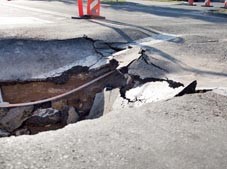Around 20 percent of the U.S. lies in areas susceptible to sinkhole events. Is your home in one of them?
Sinkholes can be serious business. Earlier this year, a sinkhole swallowed eight valuable Corvettes at a Kentucky museum. And in 2013, Jeffrey Bush died in Florida when a 60-foot-deep sinkhole suddenly opened under his home, destroying his bedroom while he was sleeping.
The U.S. Geological survey says, “Sinkholes are most common in what geologists call ‘karst terrain.’ These are regions where the type of rock below the land surface can naturally be dissolved by groundwater circulating through them. Soluble rocks include salt beds and domes, gypsum, and limestone and other carbonate rock. About 20 percent of our country is underlain by ‘karst terrain’ and is susceptible to a sinkhole event. The most damage from sinkholes tends to occur in Florida, Texas, Alabama, Missouri, Kentucky, Tennessee and Pennsylvania.”
What Is a Sinkhole?
Geologically, a sinkhole is a depression in the ground that has no natural external surface drainage. When it rains, water stays inside the sinkhole and typically drains into the subsurface.
The U.S. Geological Survey explains: “When water from rainfall moves down through the soil, karst terrain begins to dissolve and spaces and caverns develop underground. If there is not enough support for the land above the spaces, then a sudden collapse of the land surface can occur. Sinkholes are dramatic because the land usually stays intact for a period of time until the underground spaces just get too big.”
The U.S. Geological Service warns that, “…while collapses are more frequent after intense rainstorms, there is some evidence that droughts play a role as well. Areas where water levels have lowered suddenly are more prone to collapse formation.” Other factors that contribute to sinkholes are building on unstable terrain and draining of underground aquifers.
Other types of sinkholes form due to human activity. Sinkholes can develop above old mines, old cesspools or sewers or due to groundwater pumping and construction.
Are You Covered for Sinkholes?
Although the likelihood that a sinkhole will occur on your property is pretty small, damage can be extensive. In most states, the standard homeowners policy excludes coverage for damage due to “earth movement.”
However, until 2011 reforms, Florida required all homeowners policies to include coverage for sinkhole damage. Policies defined “sinkhole damage” so broadly that the number of claims surged, tripling between 2006 and 2010, and costing insurers more than $1.6 billion. After the 2011 reforms, homeowners insurers authorized by the state of Florida must cover “catastrophic ground cover collapse,” but your policy might not cover other sinkhole-related damage unless it specifically includes sinkhole coverage.
Tennessee recently amended its laws on sinkhole coverage in homeowners insurance policies. Current law requires homeowners insurers to “make available” coverage for sinkhole losses to dwellings and contents. A new law effective July 1, 2014 clarifies that coverage is optional for policyholders. It also clarifies that new policies must cover “structural damage” to the property, rather than “physical damage,” which would not include land stabilization. The law also outlines inspection requirements for insurers. Insurers sought the changes, saying that fraudulent sinkhole claims were driving up the cost of coverage. Consumer advocates say the changes will make it more difficult for homeowners to obtain coverage for sinkhole claims.
California also requires homeowners insurers in that state to offer coverage for damage resulting from “earth movement.” Since coverage is optional—and expensive—the majority of homeowners opt to go without coverage.
Although some states, such as Florida and Tennessee, map known sinkholes, engineering surveys and other technology goes only so far to detect developing or potential sinkholes. If you own or are buying a home in an area prone to sinkholes, landslide, earthquake or other “earth movement” damage, please contact us to discuss your insurance options.



